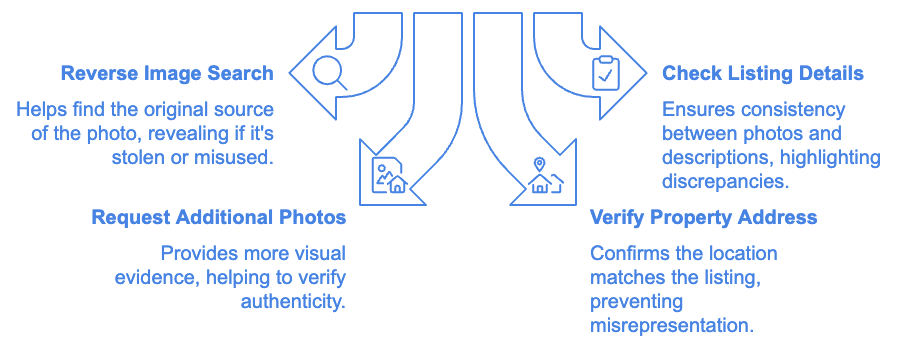
How to Avoid Rental Scams on Social Media
November 19, 2024
Emergency Rental Assistance Programs in 2025: Are They Legit?
November 29, 2024Finding the perfect rental can be exciting, but it’s easy to fall victim to rental scams, especially when scammers use fake or stolen property photos to lure unsuspecting renters. These scams often make listings look legitimate by using appealing photos of beautiful properties that either don’t exist or aren’t actually available for rent. At Section 8 Shield, we’ve seen many cases of renters losing money to these scams, and we’re here to help you identify fake property photos and protect yourself during your rental search.
This guide will explain how scammers use fake property photos, how to verify a listing’s legitimacy, and what to do if you suspect a scam. Plus, we’ll share advice from one of our readers who experienced this firsthand.
How Scammers Use Fake Property Photos
Scammers use fake property photos to create convincing rental listings. They rely on photos to attract renters and make the listing seem trustworthy. Here’s how they do it:

1. Stealing Photos from Real Listings
- Scammers copy photos from legitimate listings on rental websites, then repost them on less regulated platforms like Craigslist or Facebook Marketplace.
- The stolen photos are often paired with details from actual listings, like square footage and amenities, to make the listing seem authentic.
2. Using Stock Photos
- Some scammers use stock photos of homes or apartments that look generic but appealing. These photos often don’t represent a real property for rent.
3. Editing Photos
- In some cases, scammers manipulate real property photos to make them look different or more attractive. They might add furniture, change the background, or enhance lighting to make the listing seem unique.
4. Advertising Unrealistic Deals
Scammers often pair fake photos with enticingly low prices to catch your attention. They use phrases like “luxury apartment for half the cost” to make you act quickly before verifying the listing.
Why Fake Property Photos Work
Rental scams using fake photos work because they exploit people’s trust and urgency. Many renters assume listings are legitimate, especially when they see professional-looking photos. Scammers count on this assumption, as well as the fact that renters often feel pressure to secure housing quickly—especially in competitive markets.
One renter shared their experience with us:
Brian
34, TexasUnfortunately, stories like Brian’s are common. But by knowing what to look for, you can avoid falling into these traps.
Actionable Tips to Spot and Avoid Fake Property Photos
1. Perform a Reverse Image Search
- How It Helps: A reverse image search can reveal if the photos in a listing are used elsewhere online. Scammers often reuse photos from legitimate listings.
- How to Do It:
- Use tools like Google Images or TinEye.
- Upload the photo or paste the image URL into the search bar.
- What to Look For: If the photo appears on multiple unrelated listings or stock photo websites, it’s likely fake.
2. Check the Listing’s Details Against the Photos
- How It Helps: Inconsistencies between the photos and the listing details can be a red flag.
- What to Do: Compare the description to the photos. For example, if the listing mentions a two-bedroom apartment, but the photos clearly show a one-bedroom layout, it might be a scam.
- What to Look For: Pay attention to mismatched details, like seasonal differences (e.g., snow in the photo when it’s summer in the area).
3. Ask for Additional Photos
- How It Helps: Scammers often can’t provide extra photos, especially ones taken from specific angles or showing specific details.
- How to Do It: Request new photos of specific areas, like the bathroom or a particular room, or ask for a video walkthrough.
- What to Look For: If the landlord refuses or sends generic photos, it’s a red flag.
4. Verify the Property Address
- How It Helps: Confirming the property’s address ensures it exists and matches the listing.
- What to Do: Use Google Maps or street view to check the property. Compare it to the photos in the listing.
- What to Look For: If the property doesn’t match or doesn’t exist, the listing is likely a scam.
5. Tour the Property in Person or Virtually
- How It Helps: Seeing the property for yourself can confirm its legitimacy.
- What to Do: Schedule an in-person tour whenever possible. If you’re relocating, request a live virtual tour.
- What to Look For: Be wary if the landlord refuses to show the property or offers excuses like being out of town.
6. Research the Landlord or Agency
- How It Helps: Checking the landlord’s credentials can prevent you from dealing with fraudsters.
- What to Do: Search for reviews or complaints online, and check if the landlord or agency has a verified website or social media presence.
- What to Look For: Be cautious if you can’t find any online presence or if reviews mention scams.
7. Trust Your Instincts
- How It Helps: If something feels off, it’s worth investigating further.
- What to Do: If the price seems too good to be true or the landlord is overly pushy, take a step back and verify the details.
- What to Look For: Look for high-pressure tactics or vague answers to your questions.

How to Report Fake Listings
If you encounter a fake rental listing, take action to protect others:
1. Report the Listing on Section 8 Shield
- Section 8 Shield’s Report a Scam page allows renters to share their experiences and warn others about fraudulent listings. Your report helps build a safer rental community.
2. Alert the Platform
- Report fake listings to the platform where you found them (e.g., Facebook Marketplace, Craigslist). Most platforms have options for flagging suspicious posts.
3. Contact Local Authorities
- If you’ve been scammed or suspect fraud, file a police report. While recovery isn’t guaranteed, documenting the fraud can help prevent future scams.
4. Notify Consumer Protection Agencies
- Report the scam to agencies like the Federal Trade Commission (FTC) or your state’s consumer protection office. They track rental fraud and provide resources for victims.
What to Do If You’ve Been Scammed
If you’ve fallen victim to a rental scam using fake photos, act quickly to protect yourself:
| Contact Your Payment Provider | If you sent money, contact your bank or payment service to report fraud. In some cases, you may be able to recover your funds. |
| Monitor Your Finances | If you shared sensitive information, monitor your accounts for unauthorized activity and consider placing a fraud alert on your credit. |
| Seek Legal Help | Contact a tenant attorney or legal aid service for guidance on recovering your losses. |
Protecting Yourself from Fake Property Photos
Rental scams using fake property photos are becoming more sophisticated, but with vigilance and the right tools, you can protect yourself. Always verify listings, ask questions, and trust your instincts if something doesn’t feel right.
At Section 8 Shield, we’re here to support renters by providing resources, tools, and a platform to report scams. If you’ve encountered a suspicious listing, visit our Report a Scam page to help us alert others and prevent further fraud.
Remember: Scammers thrive on urgency and trust. Take your time, verify every detail, and don’t let pressure force you into making hasty decisions. With these precautions, you can navigate the rental market safely and confidently.




